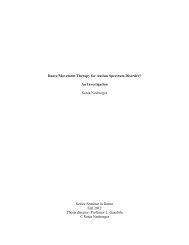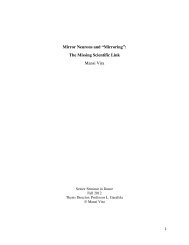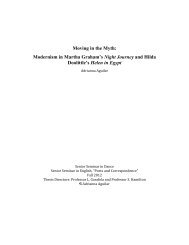Senior Thesis: 5-6 Pages - Dance - Barnard College
Senior Thesis: 5-6 Pages - Dance - Barnard College
Senior Thesis: 5-6 Pages - Dance - Barnard College
Create successful ePaper yourself
Turn your PDF publications into a flip-book with our unique Google optimized e-Paper software.
18<br />
ballet dancers. They came in, an there was no question in their minds that they could do<br />
ballet, that they should be doing it…This was completely different from where I started,<br />
which was, ‘Can I have permission to do ballet…’ There are black dancers in ballet<br />
companies around the country now, although I wish there were more black dancers in<br />
schools. Maybe things aren’t a hundred percent different now, but they’re eighty percent<br />
and moving. I think there’s a generation of artistic directions and an audience that expect<br />
things to be different, whereas in the 1950s and 1960s not only the companies but also<br />
the audiences were very resistant. No it’s not changed enough, but, yes we’re training<br />
wonderful dancers, and there are places for them to go, and it’s going to get better. 43<br />
Johnson captures the trajectory of black dancers in America who pursued a professional career in<br />
ballet. She acknowledges the significance of <strong>Dance</strong> Theatre of Harlem as a black ballet<br />
company in America. At a time when legal and cultural changes were challenging traditional<br />
notions of ballet, Arthur Mitchell had created a company that proved to America that blacks<br />
could dance ballet. The chief reason for the company’s success was the fact that integration<br />
enabled and encouraged aspiring black dancers to receive formal ballet training. Johnson is right<br />
to acknowledge that black dancers in America today no longer need to ask for permission to<br />
learn and perform ballet. She is right, too, in pointing out the role of the audience in accepting<br />
and formulating standards who can and should perform ballet. Finally, Johnson optimistically<br />
concludes that progress will continue.<br />
Johnson highlights as the problem the limited number of black dancers studying ballet.<br />
Taking classes is expensive. From a legal perspective, race does not seem to be the dominant<br />
obstacle for aspiring black dancers; rather socioeconomic factors are the main culprit preventing<br />
many from pursuing their dreams. In other words, it is no longer a question of whether or not<br />
laws dictate my right to share a stage with white peers; it is a matter of access to the resource of<br />
learning the discipline of ballet.<br />
When discussing the history of <strong>Dance</strong> Theatre of Harlem, Bremser speaks of the initial<br />
mission of the company:<br />
43 Garafola, 61.
















